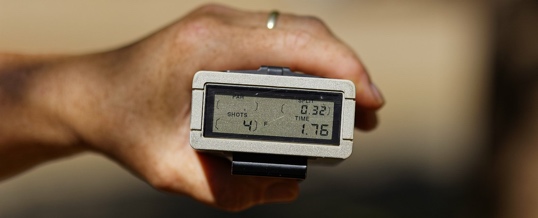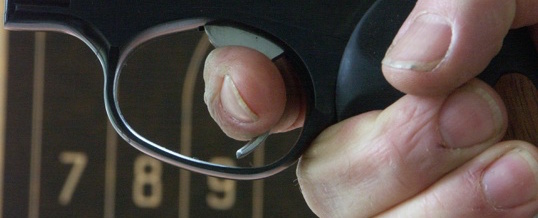
Meaningless increments of precision — and why you should avoid them
When we talk about self defense (and particularly when gun people talk about self defense), the topic of measurement will eventually come up. In the gun world we love to measure things, and we can measure just about anything. The problem is that the measurements we make may not be important.
I use the term “meaningless increments of precision” to refer to those measurements which don’t add to our self protection knowledge or to our ability to defend ourselves. The measurement may be impressive, it may be very precise, and it may be a way to compare one shooter’s athleticism to another in a limited and out-of-context manner, but it may still be meaningless — and the constant pursuit of “better” figures may not correspond to an ability to actually defend oneself with a firearm.
Should we?
Just because something can be measured doesn’t mean it’s important to measure. It’s easy to get caught up in the act of measuring without asking whether it’s something which needs to be measured in the first place.
Take, for instance, a video I watched recently. In it, a shooting instructor goes to great lengths to test three different reloading methods to find out which was the fastest — the implication being, of course, that faster equals “better”. He was very specific in his procedures and spent much time on camera detailing each method before showing the shot timer’s results. Of course he found which method was the fastest, which he then opined was the one his viewers should be using.
Completely absent from his analysis was whether it mattered.
Reloading the gun during attack is a skill which is virtually never needed. It’s hard to find instances of people actually reloading their handgun in a fight; it happens occasionally in police service, but very rarely in private sector self defense. When we consider whether or not the reload had any effect on the outcome of the incident, the instances become very rare in the law enforcement world and virtually nil in the private sector. The logical conclusion is that reloading the gun isn’t a skill that’s terribly important in the scheme of things. It doesn’t merit a lot of instructional time or practice effort, and in fact the video itself wasted more time and energy than the topic was worth.
Yes, we can measure how long it takes to reload, but in reality it’s simply not something that’s worth measuring. Timing it down to tenths or hundredths of a second, as this fellow did, is a perfect illustration of meaningless increments of precision. It could be measured, but it’s just not important to measure.
How should we?
If we’re going to measure something, we should measure appropriately. For instance, I can machine very small metal parts to very tight tolerances (I’m talking ten-thousandths of an inch.) When I’m putting molding around a door or window, however, I certainly don’t need that level of precision! Cutting to perhaps 1/32 of an inch is sufficient. Framing my dog’s new doghouse? One-eighth of an inch was just fine.
Even that level of exactness isn’t necessary when I’m cutting firewood for our woodstove. I don’t even need a measuring device for that; I can tell just by looking at a piece of wood if it’s close enough to fit. My perception of length is more than sufficient to judge.
The point is that I have various levels of measurement precision and I pick the appropriate level for the task at hand. It would be ridiculous to take my firewood to my machinist’s surface table and check its length with my precision height gauges, because it’s just not necessary for firewood to be that exact; plus or minus a couple of inches, which I can tell by eye, is more than sufficient.
As in the reloading video, defensive shooting instructors often use the timer to measure the time between shots or how quickly a gun can come out of the holster. The contention is that we need to time to that level because the human mind isn’t capable of discerning those short intervals.
Again, completely absent from the discussion is the appropriateness of that level of precision. Is the difference between 1.18 seconds and 1.28 seconds really material when it comes to defensive shooting? I contend that if you can’t tell you’re going faster, if your increments in speed as your skills increase aren’t perceptible to you, they probably aren’t important.
In a defensive shooting encounter, it’s all the other stuff which really eats up time: recognition of the attack; processing the information; making a decision; recalling the skills necessary to implement that decision (or improvising a response if no direct skills exist); and responding appropriately. Those are things which we can’t time (at least not in any consequential manner) but are what we really need to be training. Focusing on things that are easy to measure means that we’re not working on those things we can’t measure but are really important.
Been there, done that
The difference between me and the folks who espouse meaningless increments of precision is that I’ve been on both sides of the argument; by and large, they haven’t. I started out in the early 1990s shooting competition, where shot timers rule. I own several of them and have used them in competition, in classes, and in practice. I understand their strengths and limitations, but more importantly I understand their use. That is to say, I understand their misuse! A decade-and-a-half ago I sure didn’t, because I didn’t yet understand the dynamics of armed self defense nor what was important to measure. Today I do, which is why I no longer use shot timers for defensive shooting practice.
Because what they tell me usually isn’t important.
– Grant Cunningham
LISTEN to this blog post!
- Posted by Grant Cunningham
- On September 30, 2016



